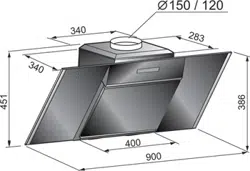Loading ...
Loading ...
Loading ...

- 9 -
INSTALLATION INSTRUCTIONS
Assembly and electrical connections must be carried out by specialised personnel.
• Electric Connection
The appliance has been manufactured as a class II, therefore no earth cable is necessary.
The connection to the mains is carried out as follows:
BROWN = L line
BLUE = N neutral
If not provided, connect a plug for the electrical load indicated on the description label. Where a plug is
provided, the cooker hood must be installed in order that the plug is easily accessible.
An omnipolar switch with a minimum opening of 3mm between contacts, in line with the electrical load and
local standards, must be placed between the appliance and the network in the case of direct connection to
the electrical network.
• The distance between the surface supporting the cooking containers on the cooking device and the bottom
of the kitchen hood must be a minimum of 65 cm (if it is a gas hob) and 45 cm (if it is an electric or induction
heating system hob).
If a connection tube composed of two parts is used, the upper part must be placed outside the lower part.
Do not connect the cooker hood exhaust to the same conductor used to circulate hot air or for evacuating
fumes from other appliances generated by other than an electrical source.
• In the case of assembly of the appliance in the suction version prepare the hole for evacuation of the air.
• We recommend the use of an air exhaust pipe with a diameter of 150. If a pipe with a smaller diameter is
used, the efficiency of the product may be reduced and its operation may become noisier
• Before starting to fix the hood, disconnect the anti-grease filter B (Fig.6) for easier appliance handling.
Before this operation, perform the following steps depending on the model purchased:
MODEL 2
Open panel C as shown in Fig.4.
Pull handle B as shown in Fig.6.
If the appliance has a lid, remove it by removing the 4 screws B as shown in Fig.9A.
• FIXING TO THE WALL
Mark the position of the lower side of the hood on the wall (Fig.2A). Maintain the minimum distance required
from the hob as shown in Fig.2B.
- Position the fixing template on the wall, making sure that the line coincides with the line previously made on
the wall.
- Mark the fixing holes and cut them into the material (Fig.3).
- Fix the 2 top screws K and screw anchors (Fig.3), without tightening them completely.
- Place the appliance against the wall, align it in horizontal position and tighten screws K (Fig.7).
- Once the adjustment has been completed, fix the hood using the 2 screws C (Fig.8).
- When carrying out the fixing operations, use only screws and screw anchors suited to the type of wall (e.g.
reinforced concrete, plasterboard etc.).
- If the screws and screw anchors are supplied with the appliance, make sure that they are suited to the type
of wall to which the hood must be fixed.
• INSTALLATION OF MODELS WITHOUT FLUE
OPTION 1 - DUCTED
- Remove the 4 screws B as shown in (Fig.9A).
- Remove both grid E on the air outlet hole and lid M as shown in (Fig.9B).
- Connect the rangehood to the flexible hose (not supplied) and the duct to the air exhaust hole previously
prepared (Fig.9C).
- Fix the lid once again by using the 4 screws previously removed in (Fig.9A).
• INSTALLATION OF MODELS WITH FLUE
OPTION 2 - DUCTED
Make sure the electrical power supply is within the measurements of the decorative connector.
Adjust the width of the support bracket of the top connector (Fig.11C). Then fix it to the ceiling so that it is on
the same axis as the hood using screws A (Fig.11C) adhering to the distance from the ceiling shown in
(Fig.11B). Connect flange C to the air exhaust hole using flexible hose L (Fig.11D).
Slide the top duct into the bottom duct. Fix the bottom duct to the hood using screws B (supplied) (Fig.11E).
Loading ...
Loading ...
Loading ...
